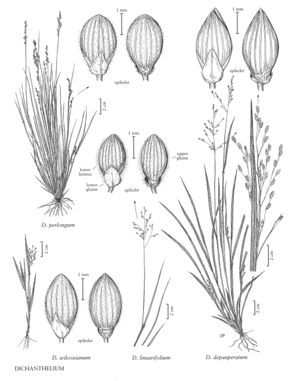Difference between revisions of "Dichanthelium depauperatum"
FNA>Volume Importer |
imported>Volume Importer |
||
| Line 4: | Line 4: | ||
|publications= | |publications= | ||
|common_names=Starved panicgrass;Panic appauvri | |common_names=Starved panicgrass;Panic appauvri | ||
| + | |special_status={{Treatment/ID/Special_status | ||
| + | |code=E | ||
| + | |label=Endemic | ||
| + | }} | ||
|basionyms= | |basionyms= | ||
|synonyms={{Treatment/ID/Synonym | |synonyms={{Treatment/ID/Synonym | ||
| Line 28: | Line 32: | ||
-->{{Treatment/Body | -->{{Treatment/Body | ||
| − | |distribution=Conn.;N.J.;N.Y.;Del.;D.C;Wis.;W.Va.;Colo.;Wyo.;N.H.;Tex.;La.;Nebr.;Tenn.;N.C.;S.C.;Pa.;Va.;Mass.;Maine;R.I.;Vt.;Ala.;Ark.;Ill.;Ga.;Ind.;Iowa;Md.;Man.;N.B.;N.S.;Ont.;P.E.I.;Que.;Ohio;Mo.;Minn.;Mich.;Kans.;Okla.;Miss.;Ky. | + | |distribution=Conn.;N.J.;N.Y.;Del.;D.C.;Wis.;W.Va.;Colo.;Wyo.;N.H.;Tex.;La.;Nebr.;Tenn.;N.C.;S.C.;Pa.;Va.;Mass.;Maine;R.I.;Vt.;Ala.;Ark.;Ill.;Ga.;Ind.;Iowa;Md.;Man.;N.B.;N.S.;Ont.;P.E.I.;Que.;Ohio;Mo.;Minn.;Mich.;Kans.;Okla.;Miss.;Ky. |
|discussion=<p><i>Dichanthelium depauperatum</i> grows in dry, open woodlands and open, disturbed areas, especially on sand. It is restricted to the Flora region. The primary panicles, which are rarely open-pollinated, are produced from May to early June; the secondary, cleistogamous panicles are produced from late June through July (rarely in fall). The species is linked with <i>D. perlongum</i> and <i>D. linearifolium</i> by occasional hybrids and hybrid derivatives. In the northern United States and Canada, 80-90% of the plants are glabrous and have been called <i>Panicum</i> depauperatum var. psilophyllum Fernald, P. depauperatum var. involutum (Torr.) Alph. Wood, or, if the primary panicles remain near the base, P. depauperatum forma cryptostachys Fernald; in this treatment, none of these is recognized as a distinct taxonomic entity. The frequency of pilose plants increases southward, where some populations are entirely pilose.</p> | |discussion=<p><i>Dichanthelium depauperatum</i> grows in dry, open woodlands and open, disturbed areas, especially on sand. It is restricted to the Flora region. The primary panicles, which are rarely open-pollinated, are produced from May to early June; the secondary, cleistogamous panicles are produced from late June through July (rarely in fall). The species is linked with <i>D. perlongum</i> and <i>D. linearifolium</i> by occasional hybrids and hybrid derivatives. In the northern United States and Canada, 80-90% of the plants are glabrous and have been called <i>Panicum</i> depauperatum var. psilophyllum Fernald, P. depauperatum var. involutum (Torr.) Alph. Wood, or, if the primary panicles remain near the base, P. depauperatum forma cryptostachys Fernald; in this treatment, none of these is recognized as a distinct taxonomic entity. The frequency of pilose plants increases southward, where some populations are entirely pilose.</p> | ||
|tables= | |tables= | ||
| Line 46: | Line 50: | ||
|illustrator=Linda A. Vorobik;Hana Pazdírková | |illustrator=Linda A. Vorobik;Hana Pazdírková | ||
|illustration copyright=Utah State University | |illustration copyright=Utah State University | ||
| − | |distribution=Conn.;N.J.;N.Y.;Del.;D.C;Wis.;W.Va.;Colo.;Wyo.;N.H.;Tex.;La.;Nebr.;Tenn.;N.C.;S.C.;Pa.;Va.;Mass.;Maine;R.I.;Vt.;Ala.;Ark.;Ill.;Ga.;Ind.;Iowa;Md.;Man.;N.B.;N.S.;Ont.;P.E.I.;Que.;Ohio;Mo.;Minn.;Mich.;Kans.;Okla.;Miss.;Ky. | + | |distribution=Conn.;N.J.;N.Y.;Del.;D.C.;Wis.;W.Va.;Colo.;Wyo.;N.H.;Tex.;La.;Nebr.;Tenn.;N.C.;S.C.;Pa.;Va.;Mass.;Maine;R.I.;Vt.;Ala.;Ark.;Ill.;Ga.;Ind.;Iowa;Md.;Man.;N.B.;N.S.;Ont.;P.E.I.;Que.;Ohio;Mo.;Minn.;Mich.;Kans.;Okla.;Miss.;Ky. |
|reference=None | |reference=None | ||
|publication title= | |publication title= | ||
|publication year= | |publication year= | ||
| − | |special status= | + | |special status=Endemic |
| − | |source xml=https:// | + | |source xml=https://bibilujan@bitbucket.org/aafc-mbb/fna-data-curation.git/src/bb6b7e3a7de7d3b7888a1ad48c7fd8f5c722d8d6/coarse_grained_fna_xml/V25/V25_1220.xml |
|subfamily=Poaceae subfam. Panicoideae | |subfamily=Poaceae subfam. Panicoideae | ||
|tribe=Poaceae tribe Paniceae | |tribe=Poaceae tribe Paniceae | ||
Revision as of 21:59, 27 May 2020
Plants cespitose. Basal rosettes poorly differentiated; blades similar in shape to the lower cauline blades, narrow, ascending. Culms 10-45 cm, erect to spreading, lower 4-10 internodes telescoped together, less than 2 cm, upper 2 internodes elongated; nodes bearded; internodes pubescent to subglabrous; fall phase a dense mass of erect blades and foreshortened branches that arise from the basal culm nodes, about 54 of the branches sterile, others with small, narrow, secondary panicles of 3-7 spikelets that remain enclosed within the sheaths. Cauline leaves 2-4; sheaths longer than the internodes, glabrous or densely ascending-pilose; ligules about 0.5 mm; blades 6-15 cm long, 1-4 mm wide, green to grayish-green, sometimes involute, glabrous or densely pilose, apices long-tapering, lower blades small to vestigial, upper 2 or 3 blades longer and stiffly erect. Primary panicles 3-6 cm long, 1.5-3 cm wide, usually long-exserted (sometimes contracted and remaining basal), with 7-25 spikelets. Spikelets 3.2-4.3 mm long, 1-1.7 mm wide, ellipsoid-pointed, glabrous or finely pubescent. Lower glumes 1.2-1.6 mm, narrowly triangular; upper glumes and lower lemmas exceeding the upper florets by 0.2-1 mm, forming a pointed beak, upper florets 1.9-3.1 mm, obovoid, minutely umbonate. 2n = 18.
Distribution
Conn., N.J., N.Y., Del., D.C., Wis., W.Va., Colo., Wyo., N.H., Tex., La., Nebr., Tenn., N.C., S.C., Pa., Va., Mass., Maine, R.I., Vt., Ala., Ark., Ill., Ga., Ind., Iowa, Md., Man., N.B., N.S., Ont., P.E.I., Que., Ohio, Mo., Minn., Mich., Kans., Okla., Miss., Ky.
Discussion
Dichanthelium depauperatum grows in dry, open woodlands and open, disturbed areas, especially on sand. It is restricted to the Flora region. The primary panicles, which are rarely open-pollinated, are produced from May to early June; the secondary, cleistogamous panicles are produced from late June through July (rarely in fall). The species is linked with D. perlongum and D. linearifolium by occasional hybrids and hybrid derivatives. In the northern United States and Canada, 80-90% of the plants are glabrous and have been called Panicum depauperatum var. psilophyllum Fernald, P. depauperatum var. involutum (Torr.) Alph. Wood, or, if the primary panicles remain near the base, P. depauperatum forma cryptostachys Fernald; in this treatment, none of these is recognized as a distinct taxonomic entity. The frequency of pilose plants increases southward, where some populations are entirely pilose.
Selected References
None.
